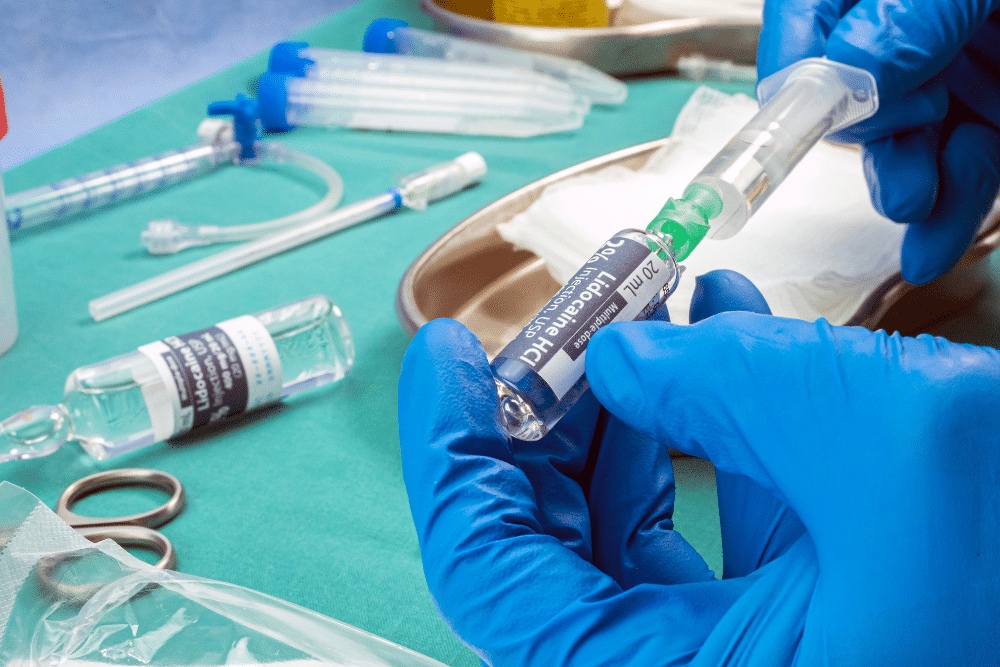
Are you considering rhinoplasty and curious about the role of local anesthesia in the procedure? Benefits of local anesthesia in rhinoplasty include reduced recovery time and a lower risk of complications., yet there are important considerations to take into account before making a decision.
Having performed numerous successful rhinoplasties, Dr. Andres Bustillo brings a wealth of expertise to the discussion of local anesthesia in facial plastic surgery. His insights and experience ensure that patients are well-informed about their anesthesia options and the implications for their surgical experience and outcomes.
Reduced Recovery Time
Local anesthesia contributes to faster recovery times in nasal surgeries. Patients typically experience a quicker return to their daily activities, as the procedure avoids the grogginess associated with general anesthesia. This means that patients undergoing rhinoplasties with local anesthesia can often leave the surgical center sooner, beginning their recovery in the comfort of their own homes.
Minimal Systemic Side Effects
General anesthesia, while safe, carries a risk of systemic side effects such as nausea, vomiting, and dizziness. In contrast, local anesthesia is applied only to noses or specific parts of the nasal structure, thereby reducing the likelihood of such side effects. The concentration of medication remains localized, offering a safer alternative for patients undergoing nasal surgery.
Enhanced Patient Comfort Post-Surgery
Post-surgical discomfort can be significantly lessened when local anesthesia is employed. In the quest for the perfect nose, patient comfort is paramount. The localized numbness not only facilitates a more comfortable surgical experience but also extends into the immediate recovery period, allowing for a more pleasant healing process.
Suitable for Minor Rhinoplasty Procedures
For patients seeking minor adjustments to their nasal bridge or other targeted areas, local anesthesia is particularly well-suited. These procedures typically require less invasive techniques, and the use of local anesthesia minimizes intervention while still achieving the desired enhancements. This suitability ensures a balance between patient safety and the pursuit of aesthetic improvements.
Types of Local Anesthesia Used in Rhinoplasty
Lidocaine: Common Choice for Quick Procedures
Lidocaine remains a top selection for various cosmetic surgery procedures, especially for quick, outpatient rhinoplasties. Surgeons prefer it for its rapid onset and relatively short duration of action. Typically, lidocaine effectively numbs the nasal area, ensuring patients remain comfortable during closed rhinoplasty or another type of rhinoplasty requiring local anesthesia.
Bupivacaine: Extended Pain Control
For longer-lasting pain relief post-procedure, bupivacaine is a preferred choice. Its effects can extend well after the surgery, which is particularly useful in complex rhinoplasty cases. Patients benefit from bupivacaine’s prolonged action, as it reduces the need for additional pain management in the hours following the surgery.

Combination Anesthetics: Tailored Pain Management
To optimize patient comfort, anesthesiologists may use a combination of different types of anesthesia. By blending various agents, including lidocaine and bupivacaine, the medical team can provide a customized anesthesia plan. This approach allows for rapid onset from lidocaine and prolonged pain control from bupivacaine, suiting the specific needs of each rhinoplasty case.
While twilight anesthesia is another one of the anesthesia options for rhinoplasties, using local anesthetics like those mentioned ensures patients are alert yet pain-free, facilitating a smoother recovery period.
Injection Technique and Safety Measures
For nose surgery, fostering a pain-free experience is paramount. We employ a refined injection technique that strategically delivers anesthesia to the required nasal zones. During this phase, adherence to safety measures is crucial to prevent complications. The surgical team meticulously:
- Confirms patient identity and surgical site
- Uses sterile equipment for anesthetic delivery
- Monitors patient vitals throughout the procedure
This attention to detail ensures the anesthesia is effective and minimizes the risk for both patient and staff as we navigate the anatomy of the nasal passages. With this surgical technique, we strive to achieve a seamless transition into the main phase of nasal surgery.
Understanding the Onset and Duration of Effect
Factors Influencing Anesthetic Effectiveness
Factors influencing anesthetic effectiveness in a surgical procedure, such as rhinoplasty, can vary depending on several factors. Plastic surgeons take into consideration the patient’s characteristics, including their facial features and the specific goals of the surgery. During the initial consultation, the surgeon may discuss the type of anesthesia that will be used, whether it’s local anesthesia or intravenous sedation. The location and size of blood vessels in the nose also play a role in determining how effective the anesthesia will be. By carefully considering these factors, plastic surgeons can ensure that the anesthesia used is tailored to each patient’s needs, ensuring optimal comfort and safety during the rhinoplasty procedure.
Timing: From Administration to Reversal
Local anesthesia timing in rhinoplasty extends from preparation to actual surgery and postoperative recovery. We begin with anesthetic administration, which, depending on the individual, may come into effect within a few minutes. Its peak efficacy occurs as surgery commences, ensuring maximum comfort for the patient. The duration of anesthesia spans throughout the procedure and is expected to last for a few hours postoperatively, safeguarding against immediate post-surgical discomfort. The reversal of anesthesia’s influence is gradual, with sensations typically returning as the medication’s concentration diminishes in the bloodstream.
Role of Anesthetics in Managing Intraoperative Sensation
Pain Management During Surgery
Anesthetics are crucial in pain management during rhinoplasties, ensuring that patients experience no discomfort as surgeons delicately work with nasal bones and tissues. The choice of anesthesia is tailored to the complexity of the procedure and the individual’s needs. Effective intraoperative pain control allows the surgeon to focus on precision without the patient’s reflexive movements, which could compromise the results.
The Impact on Patient Awareness and Comfort
Anesthesia significantly enhances patient comfort and safety by managing awareness. During nose surgery, patients may be under general anesthesia for a deep, unconscious state or twilight anesthesia for a semi-conscious state, depending on the surgery’s demands and the patient’s condition. This management of consciousness is vital to eliminate anxiety and ensure a trauma-free experience for the nose transforming.
Why Choose Local Anesthesia for Your Procedure
Patients might opt for local anesthesia in certain scenarios:
- Lower risks and fewer side effects compared to general anesthesia
- Quicker recovery time post-procedure, enabling a same-day return home
- Increased alertness shortly after the surgery, with no grogginess effect
Particularly in closed rhinoplasty, local anesthesia can be sufficient due to less extensive structural alterations. Ultimately, prioritizing safety and patient preference guides the anesthetic choice for each rhinoplasty.
Preparing for Rhinoplasty: Patient Considerations
Medical History and Anesthesia Suitability
When preparing for rhinoplasty, a thorough evaluation of medical history is crucial to determine anesthesia suitability. Patients should disclose all health conditions, specifically those affecting blood pressure or respiratory function. Relevant information includes past surgeries, especially previous rhinoplasties or revision rhinoplasty procedures, and any known allergies to medications. This assessment is crucial to avoid complications during and post-surgery.
Summing Up: Embracing the Advantages while Considering the Risks
When considering rhinoplasties under local anesthesia, both the advantages and considering risks are vital. The use of local anesthesia in these procedures, typically for closed rhinoplasty, offers distinct benefits. Patients can avoid the risks associated with general anesthesia, like the need for a breathing machine or breathing tube. The impact of anesthesia is localized, sparing the entire body from exposure. This approach often translates to swifter recovery periods.
In sum, while local anesthesia delivers several advantages for both patients and surgeons during nose jobs and potentially associated procedures like neck lifts—minimizing risk, avoiding visible scars, and allowing for easier breathing—every individual case requires a personalized assessment to determine the appropriateness of this anesthesia method for their unique noses and bodies.
Ready to take the next step? Schedule a consultation with Dr. Andres Bustillo and find out how his personalized approach to rhinoplasty can benefit you. Your ideal results await with the guidance of a seasoned professional.

